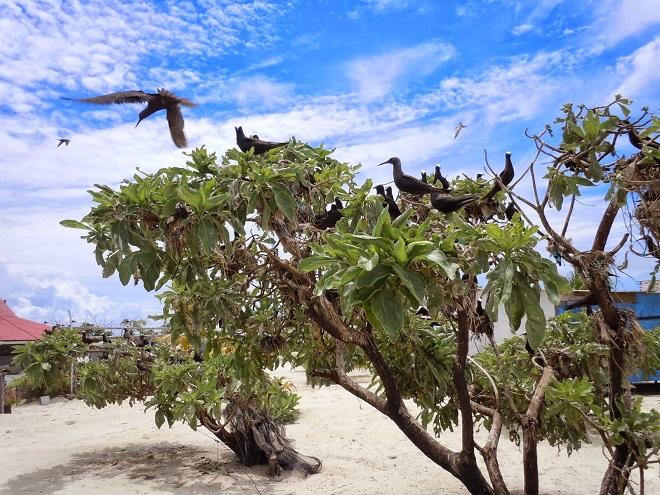Helen Island, Palau -a beautiful and unique place
by Hanny Rivera - Cohen's Lab on 18 Aug 2014

Birds of Helen Island H. Rivera
During our stay at Helen Reef, about 70 km east of Tobi Island in Palau, we were able to make a quick pit stop on the Helen island the only land for miles and miles. The island is inhabited only by three park rangers who patrol the area against illegal fishing and poaching and monitor the reefs and protect wildlife. For instance, they gather new turtle hatchling and allow them to grow up under protection before re-releasing them into the wild due to otherwise high levels of mortality and dwindling turtle populations.
The island is small and absolutely beautiful, crystal clear turquoise waters surround the shallow sandy banks that surround it and white sandy beaches make up its entire coastline. A handful of coconut palms line the horizon, along with a several small trees and few shrubs and grasses. Its most noticeable feature are the thousands of birds flying overheard, circling and cawing, probably a bit agitated to see so many humans on the island. They come there to nest and rest, and nearly every branch on every available tree is overtaken by birds, with signs of nests visible anywhere the branches meet and create a secure enough surface.
The rangers live in a small house and keep their supplies, water, fuel, and other resources under sheltered cover. There is no electricity on the island, nor refrigeration. The rangers usually stay on the island for several months at a time, often years. Transit to and from the mainland is scarce, not many boats pass this way. It's certainly a different way of life, but without a doubt a beautiful and unique place.
Helen Reef is rather isolated from any large mainland, inside the atoll is a small island less than half a square kilometer in size, uninhabited, except for three rangers who patrol the reef's marine protected area. The closest other island is Tobi Island, which has a population of less than 100.
The coral reefs at Helen suffered greatly during the 1998 El Niño year, which led to bleaching events worldwide. El Niño years result in warmer waters and temperatures. Bleaching occurs when corals lose their endosymbiotic algae, Symbiodinium, due to stress, usually extremely hot temperatures. The colors of corals are actually a result of the pigmentation in this algae, so when corals lose their symbionts the colonies appear white, as the calcium carbonate skeleton becomes visible through the coral's naturally translucent tissue - hence the term bleaching. If temperatures return to normal and the stress ceases in time (at most a few weeks), corals can re-acquire their algal symbionts and return to a healthy state; however, if they remain bleached for too long, colonies can die as they starve without the input of carbohydrates that their algae typically provide.
Much of the monitoring efforts implemented in Palau were a response to the extensive coral bleaching that occurred during 1998. Thanks to these efforts we now have data following the recovery, or lack thereof, of reefs from that time period thru today. Helen's reefs suffered dramatically during this event, but made a quick and remarkable come back, making Helen Reef an important site to characterize and understand. During our time here we collected samples and conducted surveys at various different habitats including the outer reef crest, inner reef and the channel that leads into the lagoon of Helen's atoll (the channel is the squiggly line in the satellite view above).
During our dives we found colorful and diverse reefs, thriving with life. In our first dive on the outer reef, two small reef sharks greeted us as we swam from our boat over the drop off towards the reef, which was dominated by branching corals and small fish. On our way to the second dive site a pod of dolphins followed us into Helen's lagoon, jumping over the rough waves that are typical of Helen's NW side, where several wrecks in the distant attest to the dangers of running aground onto a coral reef. In our second dive site we found plenty of massive Porites, great for our coring and tissue sampling needs. Our second day of diving was likewise full of great dive sites, with good coral, a testament to Helen Reef's resilient recovery from previous bleaching events. Overall, our work here was a success and the diving spectacular. We even got to visit the ranger's island, but I'll tell you all about that in the next post. Next stop: Kayangel.
Merand is the Palauan word for coral. The Cohen's Lab current expedition to Palau seeks to understand why some
of Palau's coral can thrive in low pH conditions.
For more information, click here
If you want to link to this article then please use this URL: www.sail-world.com/125774